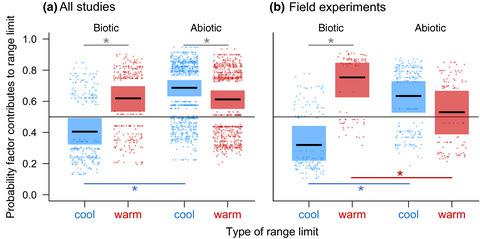当前位置:
X-MOL 学术
›
Ecol. Lett.
›
论文详情
Our official English website, www.x-mol.net, welcomes your
feedback! (Note: you will need to create a separate account there.)
Biotic interactions are more often important at species’ warm versus cool range edges
Ecology Letters ( IF 7.6 ) Pub Date : 2021-08-27 , DOI: 10.1111/ele.13864 Alexandra Paquette 1 , Anna L Hargreaves 1
Ecology Letters ( IF 7.6 ) Pub Date : 2021-08-27 , DOI: 10.1111/ele.13864 Alexandra Paquette 1 , Anna L Hargreaves 1
Affiliation

|
Predicting which ecological factors constrain species distributions is a fundamental ecological question and critical to forecasting geographic responses to global change. Darwin hypothesised that abiotic factors generally impose species’ high-latitude and high-elevation (typically cool) range limits, whereas biotic interactions more often impose species’ low-latitude/low-elevation (typically warm) limits, but empirical support has been mixed. Here, we clarify three predictions arising from Darwin's hypothesis and show that previously mixed support is partially due to researchers testing different predictions. Using a comprehensive literature review (885 range limits), we find that biotic interactions, including competition, predation and parasitism, contributed to >60% of range limits and influenced species’ warm limits more often than cool limits. Abiotic factors contributed more often than biotic interactions to cool range limits, but temperature contributed frequently to both cool and warm limits. Our results suggest that most range limits will be sensitive to climate warming, but warm-limit responses in particular will depend strongly on biotic interactions.
中文翻译:

生物相互作用在物种的温暖和凉爽边缘更重要
预测哪些生态因素会限制物种分布是一个基本的生态问题,对于预测对全球变化的地理响应至关重要。达尔文假设非生物因素通常会施加物种的高纬度和高海拔(通常是凉爽)范围限制,而生物相互作用更经常施加物种的低纬度/低海拔(通常是温暖)限制,但经验支持是混合的. 在这里,我们澄清了由达尔文假设产生的三个预测,并表明之前的混合支持部分是由于研究人员测试了不同的预测。使用全面的文献综述(885 个范围限制),我们发现生物相互作用,包括竞争、捕食和寄生,有助于 > 60% 的范围限制和影响物种的温暖限制比凉爽限制更频繁。非生物因素比生物相互作用对凉爽范围限制的贡献更多,但温度对凉爽和温暖范围的贡献频繁。我们的结果表明,大多数范围限制将对气候变暖敏感,但特别是温暖限制响应将强烈依赖于生物相互作用。
更新日期:2021-10-08
中文翻译:

生物相互作用在物种的温暖和凉爽边缘更重要
预测哪些生态因素会限制物种分布是一个基本的生态问题,对于预测对全球变化的地理响应至关重要。达尔文假设非生物因素通常会施加物种的高纬度和高海拔(通常是凉爽)范围限制,而生物相互作用更经常施加物种的低纬度/低海拔(通常是温暖)限制,但经验支持是混合的. 在这里,我们澄清了由达尔文假设产生的三个预测,并表明之前的混合支持部分是由于研究人员测试了不同的预测。使用全面的文献综述(885 个范围限制),我们发现生物相互作用,包括竞争、捕食和寄生,有助于 > 60% 的范围限制和影响物种的温暖限制比凉爽限制更频繁。非生物因素比生物相互作用对凉爽范围限制的贡献更多,但温度对凉爽和温暖范围的贡献频繁。我们的结果表明,大多数范围限制将对气候变暖敏感,但特别是温暖限制响应将强烈依赖于生物相互作用。











































 京公网安备 11010802027423号
京公网安备 11010802027423号